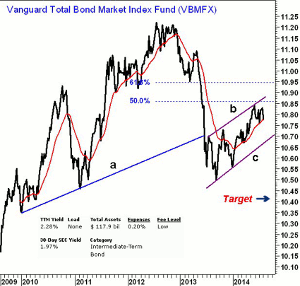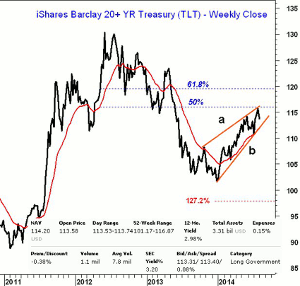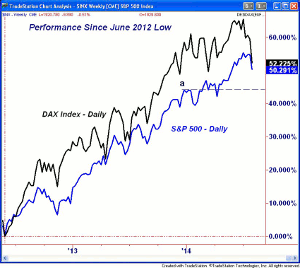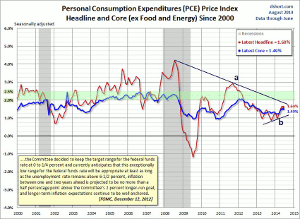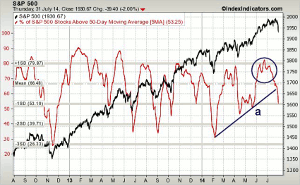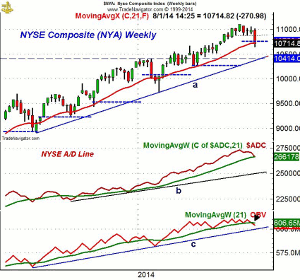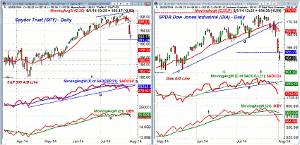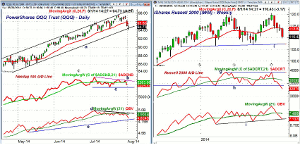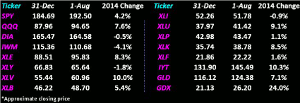Given that the stock market was hit last week with its first round of heavy selling since February, many investors have been flooding the bond market, but MoneyShow’s Tom Aspray doesn’t think those buying bond funds or ETFs will necessarily be getting their investment back.
The stock market finally got hit last with its first heavy round of selling since early February. The Dow Industrials gave up its gains for the year. It had been lagging the other market averages like the S&P 500 and Nasdaq Composite all year.
So far, this does not appear to have shaken the confidence of most investors but as I discuss in the What to Watch section, investors are likely to see further selling before we get another low risk buying opportunity.
There seems to be a more important shift going on in the market that would have more important implications for most investors. In last week’s column, I noted that the yields on junk bonds had broken their downtrend (see chart) and, a week ago, $4.8 billion was yanked out of high yield bond funds.
There were signs that the bond market may have bottomed last week as I recommended two inverse bond ETFs. It will take several weeks, if not more, before a bottom is confirmed but the timing dovetails nicely with the generally stronger economic data.
Chasing yields has been the best and most popular strategy for the first half of the year. Recent data indicates that Chinese buying has played a large role in the sharp decline in the 10-Year T-Note yields this year.
Those in search of a risk-free return have also been flooding the bond market and, while those buying Treasury instruments will eventually get all of their investment back, those buying bond funds or ETFs may not be so lucky.
The weekly chart of the Vanguard Total Bond Market Index Fund (VBMFX) shows that it peaked in July 2012 at $11.22. By August 2013 it had dropped to $10.50, a decline of 6.4%.
The long-term uptrend, line a, was broken in June 2013 and the rally from the August lows looks like a pause in the downtrend or a continuation pattern. It has taken the shape of a flag formation, lines b and c. The rebound has just retraced a bit less than 50% of the previous decline. A weekly close below $10.65 should signal that the rally is over.
The initial downside target is in the $10.40 area, which is 3.5% below current levels. VBMFX is one of the largest bond funds with total assets of $117 billion and a current yield of $1.98%. Over the past three years, the Total Return has been 2.86% so a decline to the target level would be significant. The effective maturity of its holding is 7.7 years.
Those who are in a longer maturity fund or ETF have a greater potential risk. The iShares Barclay 20+ Year Treasury (TLT) peaked at $130.38 in 2012 and had a low in late 2013 of $101.69 which was a drop of 22%.
The rally in TLT appears to have stalled just below $116 and the 50% Fibonacci retracement resistance. The chart for TLT also shows a typical continuation pattern, lines a and b.
There is initial support in the $110 area and a drop below the $105.60 level would project a drop to the 127.2% Fibonacci target at $98. This is 14.2% below current levels. Though TLT is up 13.6% YTD, the three year total return is 8.35%. It has a SEC yield of 3.2% but is it really worth the risk?
I have felt for several years that many bond fund and ETF investors do not realize the potential risk of buying and holding these instruments. I hope investors will not be singing the Bag Holders Blues later this year. This was a favorite theme song of the late Joe Granville. Its message was that the institutions would often leave the public holding the unwanted investments (bag) as a market was topping out.
The Euro zone markets, like the German Dax Index, topped in early July ahead of the US markets. It was up 65.8% from the June 2012 lows but now is up just over 52%. The chart shows that it is now about even with the S&P 500 after leading it for most of the past two years. The DAX has next good support in the 8900-9050 area which is 2.5% below current levels.
This action of the DAX is consistent with a further decline in the S&P 500 and it is likely that the DAX will bottom out ahead of the US markets but there are not signs yet of a bottom. The geopolitical conflicts in Europe, as well as the recent financial concerns, I think, just mark a pause in their recovery. However, it could force in more aggressive action by the ECB as inflation data fell to a fresh low of 0.4% last week.
NEXT PAGE: What to Watch
|pagebreak|As for the S&P, the 5 Change chart reveals good support in the 44% area (line a), which suggests there is still significant risk from current level, though I am not looking for that deep a correction.
The preliminary 2nd quarter GDP number last Wednesday came in at 4%, shocking the market that was expecting just 3%. The rally failure after the report was a bearish sign from a technical perspective that went unnoticed by the financial media.
The readings on the consumer were both better than expected with Consumer Confidence coming in at 90.9 versus an expected reading of 85.5. The University of Michigan Consumer Sentiment was at 81.8, which was just slightly better than expected.
Not all of the data was good as the Pending Home Sales data was weak and the S&P Case-Shiller HPI indicated that price appreciation is slowing rapidly. The data on manufacturing was mixed as, while the financial pundits credited the weak Chicago PMI for the market decline, the more important ISM Manufacturing Index came in at 57.1 well above the consensus estimate at 55. The Global Manufacturing PMI came in just a bit lower than expected.
The jobs report was a bit weaker than expected but more important was the Employment Cost Index which shows a year to year change of 2.0%. This is widely watched by the Fed as is the Personal Consumption Index (PCE), which was down slightly from last month, 1.6% versus 1.7%. The chart shows what appears to be a completed bottom formation (line b) and a move through the downtrend line a, would help erase some of the lingering deflationary fears.
This week we get the PMI Service Index, Factory Orders, and the ISM Non-Manufacturing Index on Tuesday. The rest of the week is pretty quiet with International Trade on Wednesday and Productivity and Costs on Friday.
What to Watch
The stock market got the world’s attention this week and, as I noted in Friday’s column, this was what the technical indicators have been warning about for several weeks. The drop caught the financial media by surprise as they tried to explain what happened.
For a good part of the week, their analysts were fixated on the strong earnings by some of the high flying momentum stocks. One station even asked their grad student on Thursday if this was a dip to buy? Now, I am all for youth, but I doubt he was even in high school when the dot.com bubble burst. To his credit, he said that he’s waiting for lower prices to buy.
I have observed every major move in the stock market since 1982 and have learned, sometimes painfully during the process. Therefore, I was quite shocked when I saw little or no coverage on the market from a technical perspective before or after last week’s drop.
The good news is that we should see a sharp snap back rally this week. If the media concludes that this was another dip to buy, the next decline could be even more severe. Of course, there are no absolutes, but the odds are very low that the market is ready to make new highs anytime soon. It is important to remember that this is still viewed as a correction within a long-term positive trend.
The rally should give everyone a chance to reexamine their portfolios and decide whether they want to raise more cash. A 100-150 point higher close in the Dow will signal the rebound is underway. Once it occurs, watch the market closely the following day.
I would expect to see a big shift in the sentiment next week as the individual investor turned slightly more bullish last week, up to just over 31% from 29.6% the prior week. A reading in the low 20s would not be surprising before the market’s decline is over.
Since early in July, I have been commenting on the topping formation (see circle) in the five-day MA of the % of S&P 500 stocks above their 50-day MAs . As of Thursday, it has dropped close to the mean at 53.25%. The uptrend, line a, has been broken so a drop below 40% would not be surprising.
What I will be looking for is a drop into the low risk area followed by a turn higher. This often coincides with bottoming signals from the A/D and volume indicators.
There are still a few big-tech favorites that are holding up well but I expect them to also be sold off before the market’s decline is over. I warned several weeks ago that Amazon.com, Inc. (AMZN) and Apple, Inc. (AAPL) were looking vulnerable. AMZN plunged several days later. AAPL is still holding up better but I would be watching the key support levels closely.
NEXT PAGE: Stocks
|pagebreak|The weekly chart of NYSE Composite (NYA) shows that we may close below the quarterly pivot at 10,758 this week. The daily chart triggered a low close doji sell signal on Friday, July 25. A weekly LCD will be triggered this week.
The 50% Fibonacci support from the April lows is at 10,687. The flattening 20-day EMA at 10,718 was tested last week. There is stronger support in the 10,414 area, which corresponds to the trend line support, line a, and the early 2014 highs.
The weekly NYSE Advanced/Decline is now testing its WMA but it did make a new high with prices in early July. As I noted last time, the daily A/D line did drop below its uptrend, line b, on July 17 (point 2), so the rally two week’s ago was treated with suspicion.
The McClellan Oscillator (not shown) looks ready to close the week around -273, which is the lowest reading since the summer of 2013 when it hit -329.
There is initial resistance now at 10,800 with the declining 20-day EMA at 10,926, which is where any rebound is likely to fail this week.
S&P 500
The Spyder Trust (SPY) I covered in quite a bit of detail on Friday and will not repeat the technical review. The technical studies did deteriorate a bit more Friday with the SPY making further new correction lows at $191.57, which was just above the quarterly pivot at $191.24.
The close was well below the doji low of the week ending July 18 so a weekly LCD sell signal was triggered on Friday.
Look for strong resistance now in the $194.50-$196.50 area.
Dow Industrials
The decline in the SPDR Dow Industrials (DIA) has been even more severe as it dropped below the quarterly pivot at $165.45 on Friday. The weekly starc- band is now at $162.59.
The Dow Industrials A/D line has plunged well below former support at line e. This now becomes strong resistance. The WMA of the A/D line is also declining and any rally is likely to fail below the WMA.
The daily OBV has also dropped below its support going back into June, line f. The OBV is well below its WMA so it is getting oversold on a short-term basis. This also favors a rebound.
Nasdaq 100
The PowerShares QQQ Trust (QQQ) tested the lower boundary of its trading channel (line b) on Friday but looks ready to close above it. There is a band of support in the $93.60-$94.20 area and the monthly pivot is at $92.82.
The monthly projected pivot support is at $91.49 with the weekly starc- band now at $90.98. The daily starc- band was exceeded in Friday’s session.
The Nasdaq 100 A/D line did form a negative divergence at the July 24 high, line b, and has now dropped below its WMA. A violation of the A/D line support, at line c, would be more negative.
The daily OBV also formed a bearish divergence at the recent highs (line d), which has been confirmed by the drop to new lows for the month. The OBV has further support at line e.
There is initial resistance now at $95.60 and the 20-day EMA with further at $96.50-$97.
Russell 2000
The iShares Russell 2000 Index (IWM) was hit hard again last week as it looks ready to close below the quarterly projected pivot support at $110.78. There is some support in the $108.50 area with major at $106.58-$107.03, line f.
The weekly A/D line did make a marginal new high in early July (line g) but last week dropped below strong support at line h. The daily Russell 2000 A/D (not shown) made further new lows last week and is still in a well established downtrend.
The weekly on-balance volume (OBV) is already back to major support at line i as it has been below its WMA for the past four weeks.
There is first chart resistance in the $112 area with the declining 20-day EMA at $113.97. There is major resistance now in the $116.50-$117.50 area.
NEXT PAGE: Sector Focus, Commodities, and Tom's Outlook
|pagebreak|Sector Focus
The iShares Dow Jones Transportation (IYT) gave us a good warning early last week as it dropped sharply on Monday and Tuesday. This kind of action in one of the strongest sectors suggested the smart money was selling.
The monthly pivot for August at $145.51 was violated Friday with the quarterly pivot still as bit lower at $141.00. The weekly OBV has dropped below its WMA and the daily studies are now negative.
There is resistance now in the $147-$148 area.
What a difference a week makes as last week the Spyder Trust (SPY) was up 7.1%, now up just 4.4%. The PowerShares QQQ Trust (QQQ) had double-digit gains but now is up around 7.7% for the year. The SPDR Dow Industrials (DIA) is now lower for the year.
The Select SPDR Energy (XLE) has given up its double digit gains as has the Select Sector Utilities (XLU).
All of the sector ETFs have given up some gains with the Select SPDR Consumer Discretionary (XLY) and the Select Sector Industrials (XLI) now negative for the year. I will be watching these two closely as the correction draws to a close.
Crude Oil
The September crude oil was hit very hard last week as it was down about $4.50 per barrel. The weekly OBV is still holding above its WMA but the daily analysis is negative.
Precious Metals
Both the Market Vectors Gold Miners ETF (GDX) and the SPDR Gold Trust (GLD) had had a fairly wide ranging week but the miners held up better than gold. There has been some loss of momentum and I will be watching for a further correction.
The Week Ahead
The stronger sell signals that were generated last week suggest that this is the start of a further correction not the end. The extent of the selling suggests we may see a drop in the Spyder Trust (SPY) to the $188-$190 area.
More ETFs have closed the week below their quarterly pivots, like the four I warned about last week. Therefore, I will update the quarterly pivot analysis this week.
If you have some good profits in a bond fund or ETF I would look at your positions closely and consider taking some profits. Look at the potential risk of these holdings if rates do start to rise. A turnaround in the bond market—when it comes—could be dramatic.
For those who are still in the process of a dollar-cost-averaging plan, I would definitely stick with your plan. If you are not, but have decided you want to be in stocks when we enter the seasonally strong fall period, now is a good time to start.
For stock traders, we took a position in a short ETF last week and if we get a rebound back to resistance this week, I may look to buy another inverse ETF.
Don't forget to read Tom's latest Trading Lesson, Finding High-Probability Entry Levels.

